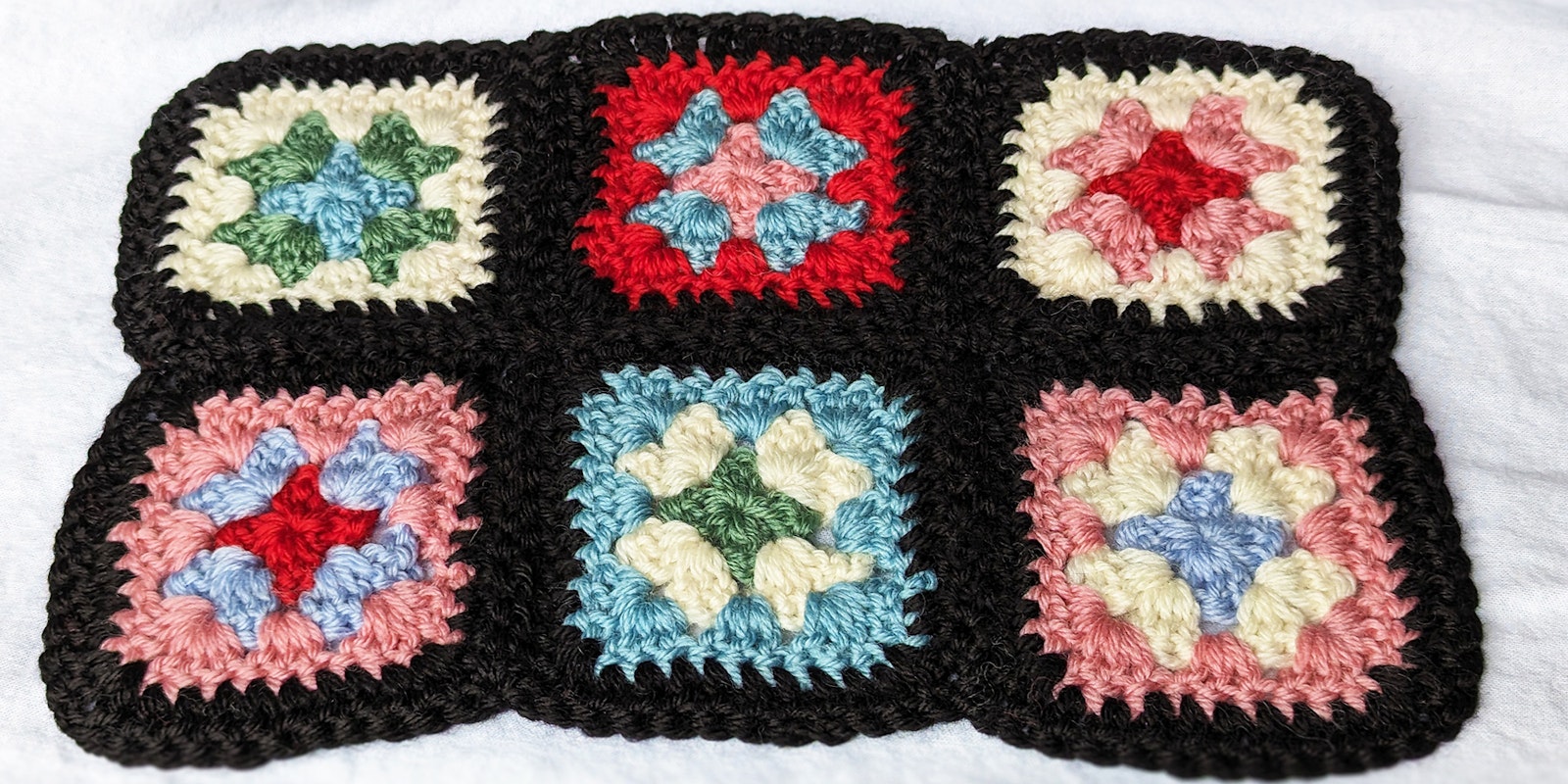Last year, while searching for an old granny-square pattern, I stumbled upon what is probably the first granny square ever. When the “Crazy Afghan” pattern was published, the world was crazy for “crazy work,” like crazy quilts and crazy pottery. The pattern was a play on that trend. And just as with crazy quilts, we now know that granny squares started with a specific design and source of inspiration, not as a folksy way to use up scraps. It’s time to give credit to the woman who created this iconic crochet motif.
 A Mrs. Phelps square, the original granny square.
A Mrs. Phelps square, the original granny square.
The Crazy Afghan pattern, published in Prairie Farmer magazine on April 4, 1885, was designed by a Mrs. Phelps (no first name given). Unlike with later published variants, the author explained her design inspiration: a crazy quilt square, with brightly colored sections and a black border. Much as American crazy quilts of the era pieced together squares of crazy work with embroidery, the “Crazy Afghan” pieced together squares of crochet with stitching. The crochet stitches at the corners even emulate the fan motif so popular in crazy quilts at the time.
 The fan motif was popular in crazy quilts during the period. Roberta Lee Barnes. Crazy Quilt with Wheel Motifs. 1887–88. The Baltimore Museum of Art: Gift of Gladys Fulton and Jean Fulton Hiss. BMA 1973.74.1. Image courtesy of the Baltimore Museum of Art
The fan motif was popular in crazy quilts during the period. Roberta Lee Barnes. Crazy Quilt with Wheel Motifs. 1887–88. The Baltimore Museum of Art: Gift of Gladys Fulton and Jean Fulton Hiss. BMA 1973.74.1. Image courtesy of the Baltimore Museum of Art
Unusually, Mrs. Phelps recommended Germantown wool for the pattern, a worsted weight yarn. At the time, most crochet patterns used crochet thread rather than yarn. Blankets made of yarn were only just coming into style in 1885. “We don’t see any knit or crocheted blankets in the colonies at all; they show up in the [United States] in the middle 19th century,” said Jay Templin, Colonial-era historical interpreter for the Jamestown-Yorktown Foundation in Virginia.
From this initial publication, we can trace the dissemination of the pattern. Prairie Farmer reprinted it with more modern terminology on January 23, 1886. On March 4, 1888, Eva Marie Niles published a version in The Boston Globe that was slightly larger and had the border we are all familiar with today. That would become the definitive pattern.
 The original Phelps square (right) is smaller with a larger and more detailed border than the Niles square (left) that became dominant
The original Phelps square (right) is smaller with a larger and more detailed border than the Niles square (left) that became dominant
The term “granny square” was a later invention. The pattern was called a “granny afghan” in the 1930s, as seen in the December 1933 edition of The New Movie Magazine. (The readers were probably the granddaughters of the women who’d originally crocheted them!) The earliest use of “granny square” found to date was in the November 24, 1953, edition of The Daily Times-News from Burlington, North Carolina.
Prairie Farmer may not be where a fiber-arts historian would seek early crochet patterns. I found it only through luck. I was searching for a “slumber robe” in Google Books, and a photo of this pattern was on the same page. How many other classic patterns launched in similar periodicals?
While the granny square has evolved from its initial creation, Mrs. Phelps deserves to be credited for an elegant little design that has outlived and outshone the fad that inspired it. Eva Marie Niles also deserves credit for the variation that became the standard we all use today. Now that we can search hundreds of historical publications from our homes, we can give designers of other classic patterns the attribution they deserve.
Resources and Further Reading
- Classified advertisement, page 19, The Daily Times-News, Burlington, North Carolina. November 24, 1953.
- Gustas, Nicole. “The World’s First Granny Square Pattern (Plus 7 More to Make).” The Yarn Queen, February 27, 2022.
- Niles, Eva Marie. “Afghan Crocheted in Blocks.” The Boston Globe, March 4, 1888.
- Phelps, Mrs. “A Crazy Pattern Afghan.” Prairie Farmer, April 4, 1885.
- “Presents from Hollywood.” The New Movie Magazine, December 1933.
- Weissman, Judith Reiter. “Crazy Patchwork: A Victorian Mania.” The Clarion, Fall 1996.
- “World Quilts: The Crazy Quilt Story.” International Quilt Museum.
Nicole Gustas studied history at Harvard University’s Extension School and was a historical researcher for TV documentaries. She now writes for the blog of New Zealand knitting shop The Yarn Queen. All samples of the Phelps and Niles granny squares were crocheted by Ruth Walden.

